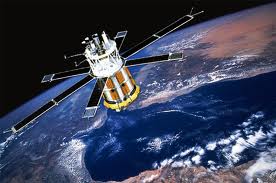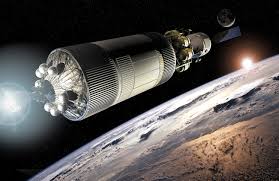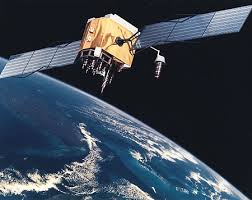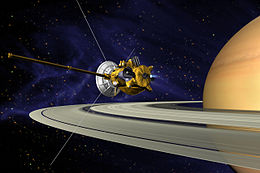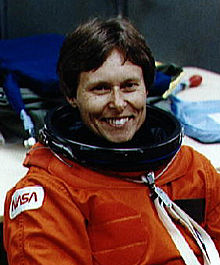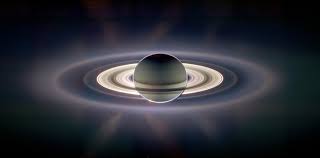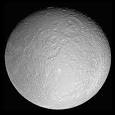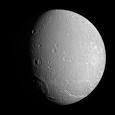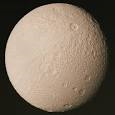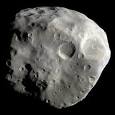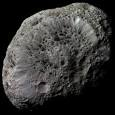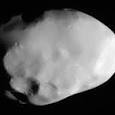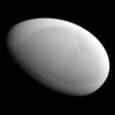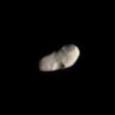About
Saturn Moons :
1]
Titan
Titan discovered
1655. The largest of Saturn's satellites at 2575±2 kilometres
radius - larger than the planet Mercury, only slightly smaller than
Mars. But much less density at 1.88. (The inner planets are all
around 5). Titan has a synchronous rotation round Saturn, it
rotates once in the same time it takes to orbit
Saturn.
Titan is
interesting, for not only is it the size of a planet, it has a
thick atmosphere, ten times the mass of the Earth's atmosphere,
which is mainly nitrogen like the Earth's. There are many chemical
reactions going on in the atmosphere of Titan, and the resulting
compounds form a layer of orange photochemical smog screening the
surface from view.
Cassini
is able to see surface features on Titan using radar. The picture
shows features seen end October, which look like a cat. Also seen
is that the thick atmosphere is in bands parallel to the equator
and has changing clouds.
The
surface temperature of Titan at -180°C is near the triple point of
methane. At a triple point, a substance can be gas, liquid or
solid. The atmosphere of Earth early in its history, some four
thousand million years ago may have been similar to the present
atmosphere on Titan, and study of the chemical processes on taking
place on Titan might give clues to the formation of life on
Earth.
2]
Lapetus
discovered in 1671,
is 718±8 kilometres in radius with a density of 1.21. It is half
one colour, half another. Its leading hemisphere is dark red in
colour, with an albedo of 0.1. (The albedo is the reflected light,
total reflection of light, that is the maximum brightness possible,
is 1). The trailing hemisphere of Iapetus is light coloured with an
albedo of 0.5. This bright side is heavily cratered. The dark
floors of craters near the edge of the pale side indicate the dark
red of the other side may be the main colour of the whole body, not
a coating collected from space. Information from Cassini shows that
Iapetus is divided all around its equator by a mountainous ridge in
some places about 13 km high. Further research helped by the
Cassini mission has shown that Iapetus is much as it was soon after
the formation of the solar system. Its bulging midsection with a
ridge of mountains along its equator, and slow spin rate may be
caused by heating from long-extinct radioactive elements present
when the solar system was born. Names of features on Iapetus are
taken from the Mediaeval French epic Chanson de
Roland.
3]
Rhea
discovered in 1672 is
764±4 kilometres in radius with a density of 1.33. It is made of
rock and ice, with slightly more ice than rock. It has a high
albedo of 0.6 so it must have a fairly clean icy surface. At the
low temperatures this far from the Sun, ice can be frozen very hard
- so that it can be frozen into a state when it behaves more like a
kind of rock. The icy surface of Rhea is heavily pocked with impact
craters. This indicates that there has been little geological
activity in recent times in Rhea's history. Early in Rhea's
history, there was geological activity resulting in large troughs,
faults or chasms, like the Kun Lun Chasma. The names of features on
Rhea's surface are all taken from the world's creation
myths.
4] Dione
:
was discovered in
1684. Its radius is 559±5 kilometres, and density 1.44. It has a
bright icy surface, albedo 0.5. Its leading hemisphere is brighter
than its trailing hemisphere. There are three main types of terrain
- heavily cratered, lightly cratered plains, and smooth plains with
few craters. As geological activity obliterates earlier features
such as craters, a heavily cratered surface indicates an older
surface and the comparative age of other features can be
ascertained by the partial obliteration of earlier features. Dione
had active volcanism up to about two and a half thousand million
years ago, and changes have continued to occur on its surface.
There are active tectonic faults, which look like long pale wispy
streaks in the Voyager 2 pictures. From Cassini in December 2004
these are seen to be bright ice cliffs created by tectonic
fractures. The names of Dione's features are taken from Virgil's
Aeneid.
5]
Tethys :
was discovered in
1684. It is 524±5 kilometres in radius, with a density of 1.26. It
has two very impressive surface features. It is encircled by a
mighty chasm, the Ithaca Chasma, which is 2.500 kilometres long and
up to 100 kilometres wide, and about 3 kilometres deep. In the
centre of this is its possible cause, the remains of the giant
Odysseus crater, which has long since settled (relaxed) into the
surface terrain. The body causing this massive crater landed a long
time ago, and nothing much has happened to Tethys since
.
6] Polydeuces
A tiny moon, about 5 kilometers across discovered by Professor Carl
Murray at Queen Mary, University of London, in October 2004.
Polydeuces is a companion, or Trojan, moon of Dione. Trojan moons
are found near gravitationally stable points ahead or behind a
larger moon. Saturn is the only planet known to have moons with
companion Trojan moons.
7] Enceladus
:
Enceladus was discovered in 1789. It has a radius
of 251±5 kilometres and density of 1.24. It is in 2:1 resonance
with Dione, so they have a tidal effect on each other.Enceladus has
a very mixed terrain, at least five different types of scenery.
Cratered material is divided and covered by great curved grooves
and flows of material which may have erupted from them. Straight
grooves at angles to each other by these sites, may be fracture
faults. In July 2005, Cassini skimmed just 175 km above the surface
and saw white boulders scattered on the surface about 10m.-20m.
across. (see picture). They do not fill the cracks so they appear
to have formed earlier. The surface is very bright - nearly 1, so
it must be covered by recent icy frost and other indications have
been found recently by Cassini that Enceladus is geologically
active with hot eruptions still occuring under its icy surface
which are caused by tidal heating. There is a water vapour
atmosphere.
8] Mimas :
was
discovered in 1789. It is 197±3 kilometres in radius, with a
density of 1.17. It is heavily cratered. One crater, called
Herschel after William Herschel who discovered Mimas, is absolutely
huge in comparison with the size of the planetary body - 130
kilometres in diameter The impact of an object large enough to
cause a crater that size must have come near to breaking up the
planet, giant cracks cross the surface. Apart from Herschel, other
features are named from Mallory's L'Morte d'Arthur
.
9] Hyperion :
Hyperion was discovered in 1848. It is a dark reddish colour, and
battered by so many craters it looks spongy.
Recent fly-pasts have shown that Hyperion is indeed spongy with a
density only half that of water.Its surface has water ice mixed
with frozen carbon-dioxide, and more complex
hydro-carbons.
10] Prometheus
:
discovered 1980 by Voyager 1. Prometheus seems to be connected to
the F-ring by a stream of material.
11] Pandora
:
Pandora also discovered in 1980 are are each side of the F-ring as
"shepherds". Pandora is about 84 km in diameter and is covered with
craters filmed by icy dust. Its two largest craters are about 30km
across.
12] Jenus
:
Both found by Voyager in 1980, have ancient craters, and are in the
same orbit, but when they catch up with each other, they do not
collide as their gravitational fields cause them to bounce off each
other without touching, and they swap orbits about every four
years. They are responsible for a wavy pattern in Saturn's rings.
They are mostly water ice and rubble. At 116 kilometres across,
Epimetheus is slightly smaller than Janus at 181 kilometres
across.
13] Pan :
Pan 20 km across, orbits Saturn in the Encke gap of the A ring and
was discovered in 1990 - it maintains the Encke gap.
14] Phoebe :
Phobe was discovered in 1898. It is the farthest out from Saturn of
all its orbiting satellites and goes round it the wrong way to the
others. Closer investigation on the Cassini mission confirmed as
suspected that Phoebe is probably a captured Kuiper belt object,
and is very cold (minus 163 degrees Celsius) with a much battered,
dirty icy surface. Phoebe has a density consistent with that of the
only Kuiper Belt objects for which densities are known. Phoebe's
mass, combined with an accurate volume estimate from images, yields
a density of about 1.6 grams per cubic centimeter (100 pounds per
cubic foot), much lighter than most rocks but heavier than pure
ice, which is about 0.93 grams per cubic centimeter (58 pounds per
cubic foot). This suggests a composition of ice and rock similar to
that of Neptune's moon Triton and Kuiper belt
objects.
Inieresting Fcats about Saturn
1]
Saturn is the second largest planet in the Solar System after
Jupiter. It is so big that Earth could fit into it 755
times.
2]
Saturn is twice as far away from the Sun as Jupiter
is.
3]
Saturn's largest moon, Titan, is the only moon in the Solar System
to possess an atmosphere.
4]
Christiaan Huygens, the Dutch astronomer who discovered Saturn's
moon Titan in 1655, also invented the pendulum
clock.
5]
The first sounds to be recorded from any other world in the solar
system were recorded from Saturn's moon Titan by the Huygens space
probe in 2005.
6]
Saturn has such a low density (meaning that its particles are far
apart) that, if there was an ocean big enough, Saturn would float
on it. In comparison, Earth and Mercury would sink to the bottom
quickest.
7]
A year on Saturn would take almost thirty Earth years. However, a
day on Saturn is about 10 and a half hours.
8]
If Earth had rings than spanned as far out as Saturn's, they would
reach about three quarters of the way to the Moon.


